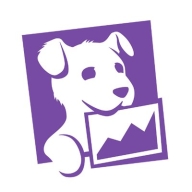

Datadog and meshIQ Kafka are competitive solutions in application monitoring and data streaming. Datadog leads in ease of use and support, while meshIQ Kafka offers superior features for Kafka environments. Datadog's balanced approach justifies its cost.
Features: Datadog provides comprehensive monitoring with real-time analytics, seamless integration, and extensive alerting functions, useful for diverse IT operations. meshIQ Kafka offers sophisticated streaming management features, detailed cluster analytics, and automation tools for Kafka optimization.
Ease of Deployment and Customer Service: Datadog has a straightforward deployment process with comprehensive guidance and responsive support, making it accessible for businesses of varied technical expertise. meshIQ Kafka has a more complex setup but is supported by strong customer service to assist in deployment challenges, suitable for Kafka-specific applications.
Pricing and ROI: Datadog is perceived to offer transparent pricing, providing value through quick insights and reduced troubleshooting time, leading to substantial ROI. meshIQ Kafka has a higher initial cost due to its advanced features, targeting organizations with a heavy reliance on Kafka, with ROI achieved through optimized data streaming operations.

Datadog is a comprehensive cloud monitoring platform designed to track performance, availability, and log aggregation for cloud resources like AWS, ECS, and Kubernetes. It offers robust tools for creating dashboards, observing user behavior, alerting, telemetry, security monitoring, and synthetic testing.
Datadog supports full observability across cloud providers and environments, enabling troubleshooting, error detection, and performance analysis to maintain system reliability. It offers detailed visualization of servers, integrates seamlessly with cloud providers like AWS, and provides powerful out-of-the-box dashboards and log analytics. Despite its strengths, users often note the need for better integration with other solutions and improved application-level insights. Common challenges include a complex pricing model, setup difficulties, and navigation issues. Users frequently mention the need for clearer documentation, faster loading times, enhanced error traceability, and better log management.
What are the key features of Datadog?
What benefits and ROI should users look for in reviews?
Datadog is implemented across different industries, from tech companies monitoring cloud applications to finance sectors ensuring transactional systems' performance. E-commerce platforms use Datadog to track and visualize user behavior and system health, while healthcare organizations utilize it for maintaining secure, compliant environments. Every implementation assists teams in customizing monitoring solutions specific to their industry's requirements.
meshIQ Kafka offers a comprehensive platform designed to streamline event streaming processes. By leveraging advanced features, this platform enhances data processing capabilities, ensuring efficient integration and analysis for businesses seeking robust event communication.
Designed for those familiar with event streaming, meshIQ Kafka provides a solution built for scalability and performance. It facilitates seamless integration across architectures, promoting real-time analytics and data pipeline efficiency. Its architecture supports resilience and adaptability, making it suitable for high-demand environments. Integration with existing infrastructures is simplified, allowing organizations to utilize their data assets effectively.
What are the core features of meshIQ Kafka?
Why consider meshIQ Kafka for your organization?
MeshIQ Kafka is widely adopted in industries such as finance, healthcare, and retail. In the financial sector, it powers real-time transaction processing and fraud detection systems. Healthcare organizations use it for patient data streaming and analysis, while retail businesses implement it to optimize customer experience through data-driven insights.
We monitor all IT Infrastructure Monitoring reviews to prevent fraudulent reviews and keep review quality high. We do not post reviews by company employees or direct competitors. We validate each review for authenticity via cross-reference with LinkedIn, and personal follow-up with the reviewer when necessary.